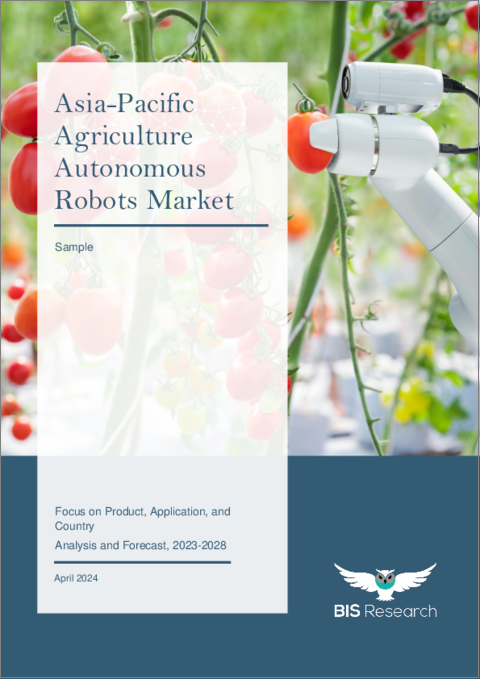|
|
市場調査レポート
商品コード
1473654
アジア太平洋の農業用自動ロボット市場:製品・用途・国別の分析・予測 (2023-2028年)Asia-Pacific Agriculture Autonomous Robots Market: Focus on Product, Application, and Country - Analysis and Forecast, 2023-2028 |
||||||
カスタマイズ可能
|
|||||||
| アジア太平洋の農業用自動ロボット市場:製品・用途・国別の分析・予測 (2023-2028年) |
|
出版日: 2024年05月07日
発行: BIS Research
ページ情報: 英文 60 Pages
納期: 1~5営業日
|
全表示
- 概要
- 図表
- 目次
中国を除くアジア太平洋地域の農業用自動ロボットの市場規模は、2023年の1億2,120万米ドルから、予測期間中はCAGR 23.45%で推移し、2028年には3億4,760万米ドルの規模に成長すると予測されています。
農業用自動ロボット市場の成長が期待される背景には、効率的かつ持続可能な農法に対する需要の高まりがあります。
| 主要市場統計 | |
|---|---|
| 予測期間 | 2023-2028年 |
| 2023年評価 | 1億2,120万米ドル |
| 2028年予測 | 3億4,760万米ドル |
| CAGR | 23.45% |
アジア太平洋の農業用自動ロボット市場は、同地域の進化する農業情勢と先端技術の採用増加に後押しされ、大きな成長を遂げようとしています。アジア太平洋地域には大規模で多様な農業部門があり、生産性、効率性、持続可能性を高める必要性が高まっています。自動ロボットは、植え付け、モニタリング、収穫、農薬散布などのさまざまな作業を自動化することで、こうした課題に対処するソリューションを提供します。さらに、労働力不足、人件費の上昇、精密農業の必要性といった要因が、同地域における自動ロボットの需要をさらに押し上げています。中国、日本、インド、オーストラリアなどの国々では、政府の取り組み、技術の進歩、農業における自動化の利点に対する意識の高まりに支えられ、農業用自動ロボットの導入が急増しています。同地域が農業慣行の近代化を続けていることから、アジア太平洋地域の農業用自動ロボット市場は堅調な成長とイノベーションが期待されています。
当レポートでは、アジア太平洋の農業用自動ロボットの市場を調査し、業界の動向、エコシステム、進行中のプログラム、ケーススタディ、市場規模の推移・予測、地域/主要国別の詳細分析、競合情勢、主要企業のプロファイルなどをまとめています。
市場の分類
セグメンテーション1:用途別
- 作物モニタリング
- 家畜モニタリング・管理
- 収穫・ピッキング
- 除草
- その他
セグメンテーション2:製品別
- 農作物収穫・ピッキングロボット
- 除草ロボット
- 搾乳ロボット
- 作物・家畜モニタリングロボット
- その他
セグメンテーション3:国別
- 日本
- 韓国
- オーストラリア
- その他
目次
調査範囲
エグゼクティブサマリー
第1章 市場
- 業界展望
- 進行中の動向
- エコシステム/進行中のプログラム
- 事業力学
- 事業促進要因
- 事業上の課題
- 市場戦略・展開
- 事業機会
- ケーススタディ
- 資金調達と投資の情勢
第2章 地域
- 中国
- アジア太平洋
- 韓国
- オーストラリア
- 日本
- その他のアジア太平洋地域
第3章 市場:競合ベンチマーキング・企業プロファイル
- 競合ベンチマーキング
- 競合ポジションマトリックス
- 市場シェア分析
- 企業プロファイル
- XMACHINES
第4章 調査手法
List of Figures
- Figure 1: Factors Driving the Need for Agriculture Autonomous Robots Market
- Figure 2: Asia-Pacific Agriculture Autonomous Robots Market, $Billion, 2022-2028
- Figure 3: Market Dynamics of the Asia-Pacific Agriculture Autonomous Robots Market
- Figure 4: Asia-Pacific Agriculture Autonomous Robots Market (by Application), $Billion, 2022-2028
- Figure 5: Asia-Pacific Agriculture Autonomous Robots Market (by Product), $Billion, 2022-2028
- Figure 6: Agriculture Autonomous Robots Market (by Region), $Billion, 2022
- Figure 7: Asia-Pacific Sales Value of Organic Food Production, $Billion, 2017-2021
- Figure 8: Agriculture Workforce Trend in the U.S, 1950-2050
- Figure 9: Percentage Share of Individuals Using Internet in Urban and Rural Areas, 2019-2022
- Figure 10: Share of Key Market Strategies and Developments, January 2019-September 2023
- Figure 11: Share of Product Development and Innovations (by Company), January 2019-September 2023
- Figure 12: Share of Market Development (by Company), January 2019-September 2023
- Figure 13: Share of Mergers and Acquisitions (by Company), January 2019- September 2023
- Figure 14: BouMatic - Case Study
- Figure 15: Tevel
- Figure 16: Investment and Funding Landscape (by Year), $Million, January 2019-September 2023
- Figure 17: Investment and Funding Landscape (by Company), Share (%), 2019-September 2023
- Figure 18: Investment and Funding Landscape (by Country), Share (%), 2019- September 2023
- Figure 19: Competitive Benchmarking Matrix for Key Agriculture Autonomous Robot Providers
- Figure 20: Market Share Analysis of Agriculture Autonomous Robots Market, 2022
- Figure 21: XMACHINES: Product and Customer Portfolio Analysis
- Figure 22: Data Triangulation
- Figure 23: Top-Down and Bottom-Up Approach
- Figure 24: Assumptions and Limitations
List of Tables
- Table 1: Key Consortiums and Associations in the Agriculture Autonomous Robots Market
- Table 2: Description and Impact of Government Initiative
- Table 3: List of Key Companies Providing Small Robots
Introduction to Asia-Pacific Agriculture Autonomous Robots Market
The Asia-Pacific agriculture autonomous robots market (excluding China) was valued at $121.2 million in 2023, and it is expected to grow with a CAGR of 23.45% during the forecast period to reach $347.6 million by 2028. The expected growth of the agriculture autonomous robots market is propelled by the growing demand for agricultural practices that are both efficient and sustainable.
| KEY MARKET STATISTICS | |
|---|---|
| Forecast Period | 2023 - 2028 |
| 2023 Evaluation | $121.2 Million |
| 2028 Forecast | $347.6 Million |
| CAGR | 23.45% |
Market Introduction
The Asia-Pacific (APAC) Agriculture Autonomous Robots market is poised for significant growth fueled by the region's evolving agricultural landscape and the increasing adoption of advanced technologies. With the APAC region being home to a large and diverse agricultural sector, there's a growing need to enhance productivity, efficiency, and sustainability. Autonomous robots offer solutions to address these challenges by automating various tasks such as planting, monitoring, harvesting, and spraying pesticides. Additionally, factors such as labor shortages, rising labor costs, and the need for precision agriculture further drive the demand for autonomous robots in APAC. Countries like China, Japan, India, and Australia are witnessing a surge in the adoption of agriculture autonomous robots, supported by government initiatives, technological advancements, and a growing awareness of the benefits of automation in agriculture. As the region continues to modernize its farming practices, the APAC Agriculture Autonomous Robots market is expected to experience robust growth and innovation.
Market Segmentation:
Segmentation 1: by Application
- Crop Monitoring
- Livestock Monitoring and Management
- Harvesting and Picking
- Weeding
- Others
Segmentation 2: by Product
- Crop Harvesting and Picking Robot
- Weeding Robot
- Milking Robot
- Crop and Livestock Monitoring Robot
- Others
Segmentation 3: by Country
- Japan
- South Korea
- Australia
- Rest-of-Asia-Pacific
How can this report add value to an organization?
Product/Innovation Strategy: The product segment helps the reader understand the different technologies used for agriculture autonomous robots and their potential. Moreover, the study gives the reader a detailed understanding of the different solutions provided by the agriculture autonomous robot equipment providers, such as imaging, AI, and analyzing. Compared to conventional agricultural methods, the agriculture autonomous robots market enables more exact targeting of planting, weeding, and harvesting, allowing farmers to save money by maximizing the use of their inputs.
Growth/Marketing Strategy: The agriculture autonomous robots market has seen major development by key players operating in the market, such as business expansion, partnership, collaboration, and joint venture. The favored strategy for the companies has been partnership, collaboration, and joint venture activities to strengthen their position in the Asia-Pacific agriculture autonomous robots market.
Competitive Strategy: Key players in the Asia-Pacific agriculture autonomous robots market analyzed and profiled in the study, including their market segments covered by distinct products, applications served, and regional presence, as well as the influence of important market tactics. Moreover, a detailed competitive benchmarking of the players operating in the Asia-Pacific agriculture autonomous robots market has been done to help the reader understand how players stack against each other, presenting a clear market landscape. Additionally, comprehensive competitive strategies such as partnerships, agreements, and collaborations will aid the reader in understanding the untapped revenue pockets in the market.
Table of Contents
Scope of the Study
Executive Summary
1 Markets
- 1.1 Industry Outlook
- 1.1.1 Ongoing Trends
- 1.1.1.1 Emerging Climate Smart Agriculture Practices
- 1.1.1.2 Emerging Sustainable Solution: Agrivoltaics
- 1.1.2 Ecosystem/Ongoing Programs
- 1.1.2.1 Consortiums and Associations
- 1.1.2.2 Government Initiatives and Their Impacts
- 1.1.1 Ongoing Trends
- 1.2 Business Dynamics
- 1.2.1 Business Drivers
- 1.2.1.1 Need for Organic Food Production
- 1.2.1.2 Agriculture Labor Shortage
- 1.2.2 Business Challenges
- 1.2.2.1 High Initial Investment and Cost
- 1.2.2.2 Less Adoption among Small-Scale Farmers
- 1.2.3 Market Strategies and Developments
- 1.2.3.1 Business Strategies
- 1.2.3.1.1 Product Development and Innovations
- 1.2.3.1.2 Market Development
- 1.2.3.2 Corporate Strategies
- 1.2.3.2.1 Mergers and Acquisitions
- 1.2.3.2.2 Partnerships, Collaborations, Joint Ventures, and Alliances
- 1.2.3.2.3 Others
- 1.2.3.1 Business Strategies
- 1.2.4 Business Opportunities
- 1.2.4.1 Rise of Small Farm Robots
- 1.2.4.2 Focus on Innovative Solutions
- 1.2.5 Case Studies
- 1.2.1 Business Drivers
- 1.3 Funding and Investment Landscape
- 1.3.1 Funding Analysis (by Year)
- 1.3.2 Funding Analysis (by Company)
- 1.3.3 Funding Analysis (by Country)
2 Regions
- 2.1 China
- 2.2 Asia-Pacific
- 2.2.1 South Korea
- 2.2.2 Australia
- 2.2.3 Japan
- 2.2.4 Rest-of Asia-Pacific
3 Markets - Competitive Benchmarking & Company Profiles
- 3.1 Competitive Benchmarking
- 3.1.1 Competitive Position Matrix
- 3.1.2 Market Share Analysis
- 3.2 Company Profiles
- 3.2.1 XMACHINES
- 3.2.1.1 Company Overview
- 3.2.1.2 Product and Customer Portfolio Analysis
- 3.2.1 XMACHINES
4 Research Methodology
- 4.1 Data Sources
- 4.1.1 Primary Data Sources
- 4.1.2 Secondary Data Sources
- 4.2 Market Estimation and Forecast
- 4.2.1 Factors for Data Prediction and Modeling





